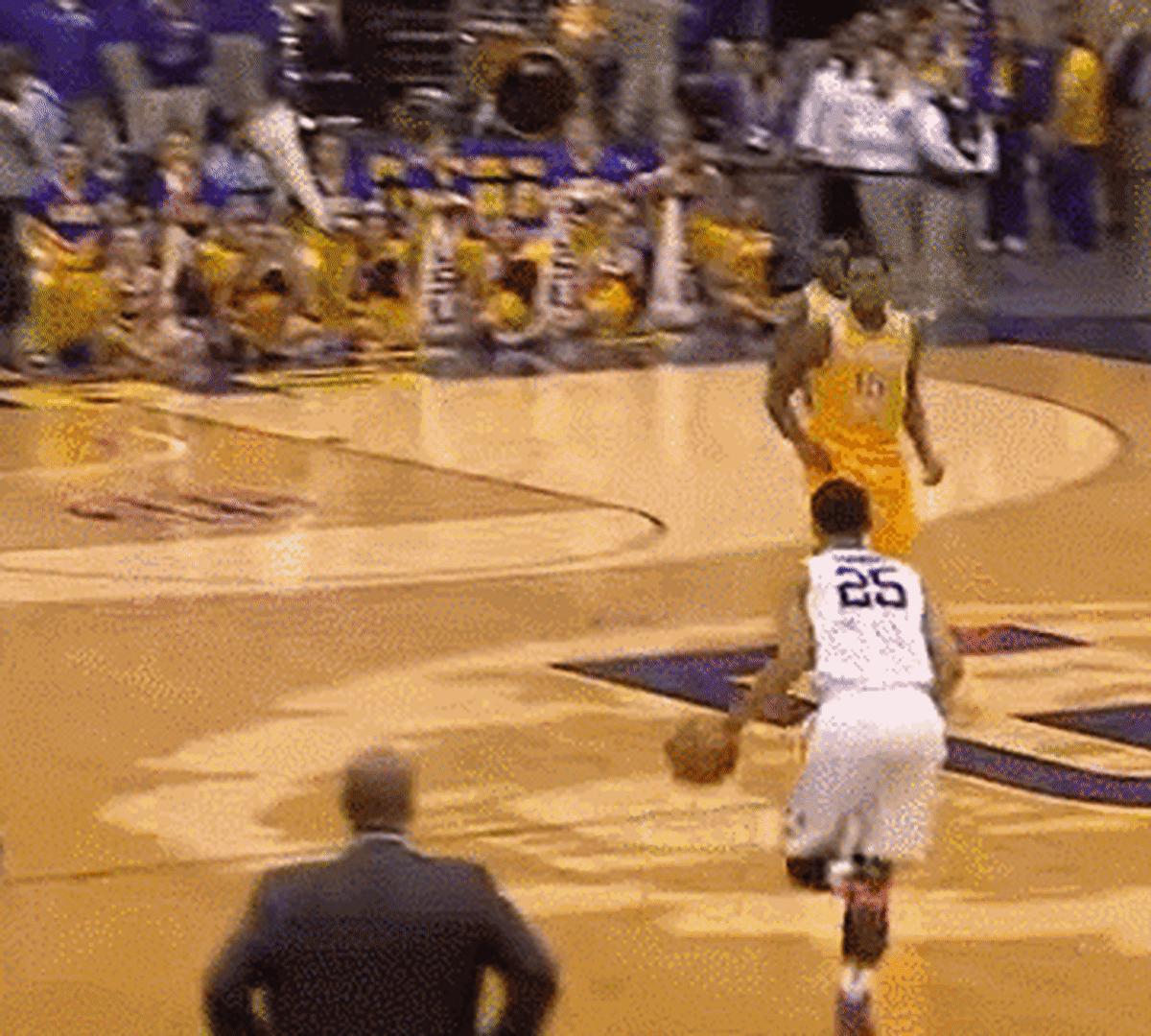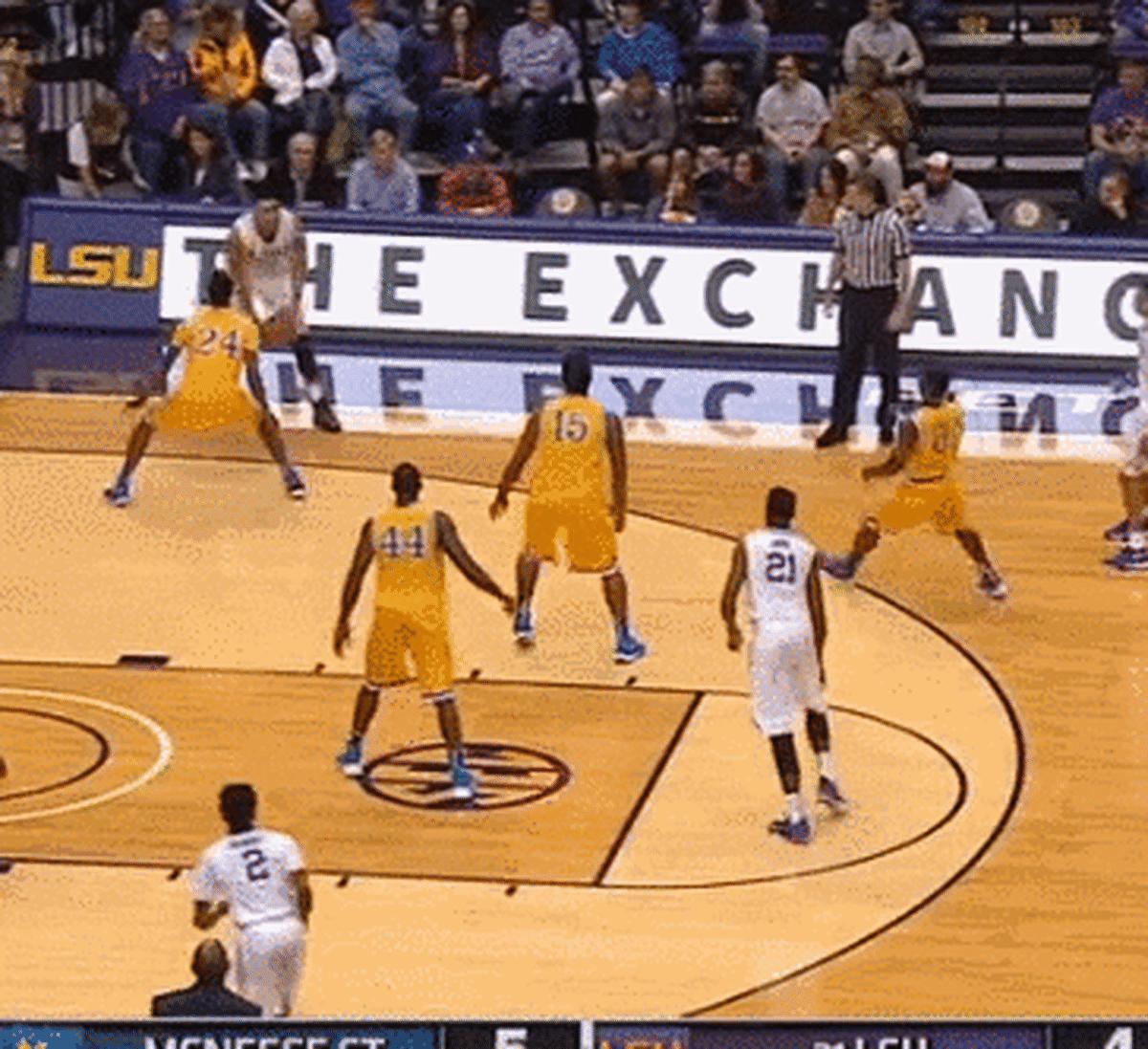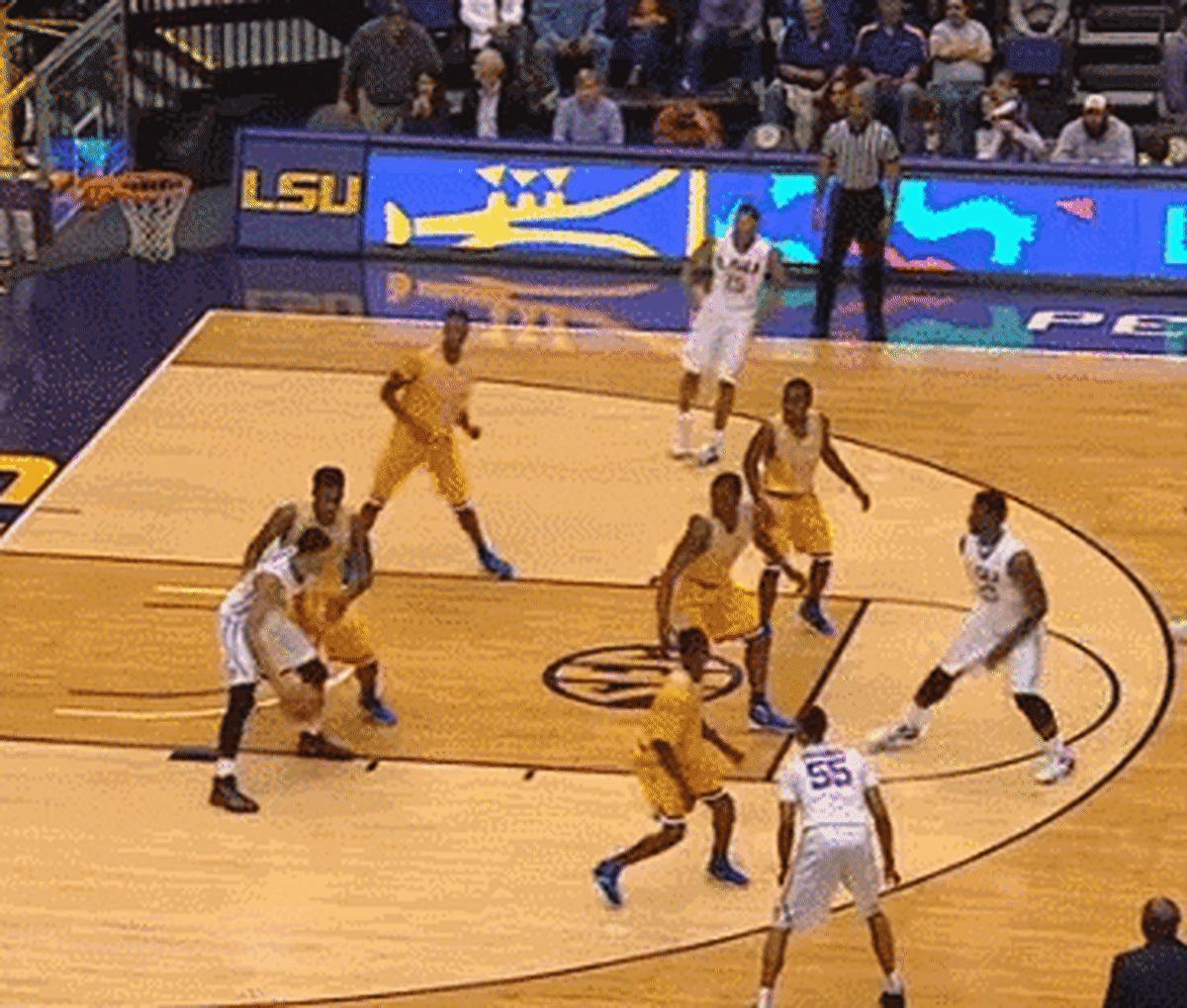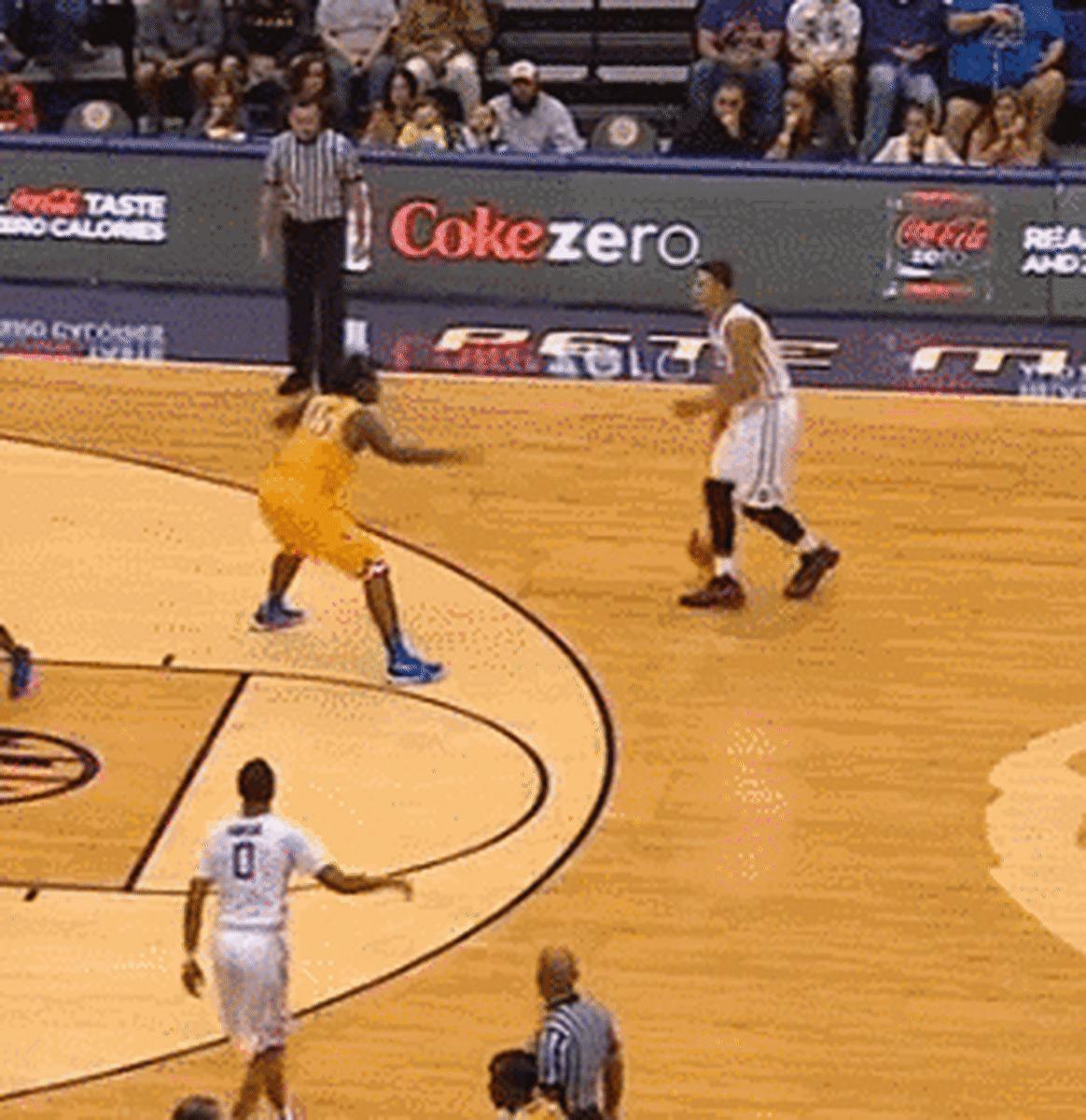Good signs for top NBA prospects Ben Simmons, Brandon Ingram

Through the first week of the NCAA season, no one has made a bigger splash than LSU freshman Ben Simmons, who is more than living up to the hype of being the consensus No. 1 recruit in the country. He’s putting up crazy stats — 16.5 points, 11.0 rebounds, 5.5 assists, 2.0 steals and 2.0 blocks a game on 62.5 percent shooting — but there’s only so much you can take away from games against McNeese State and Kennesaw State. What you can take away and what jumps off the screen already is the way that he has been playing and how well he carries himself on the court.
Simmons is a 19-year old with the poise of a 10-year NBA veteran. Nothing seems to rattle him. He plays at his own speed and he always seems to be under control. What a lot of young guys with elite athleticism don’t seem to understand is that just because you can go 100 miles per hour doesn’t mean you always should. Simmons has all the gears — he can go from 40 to 60 to 80 in a blink of an eye, and he never goes any faster than he has too. He thinks the game at a high level, and knows exactly what he is doing on the court.

At 6-foot-9, 240 pounds, with a 7-foot wingspan, Simmons already has an NBA-ready body. He’s an elite athlete who can slide his feet on the perimeter on defense and play above the rim on offense. He flies around the court and makes things happen on both sides of the ball. He would be a high-level prospect if all he did was catch lobs at the rim, and he can do so much more than that. Look how easy he makes this lob look. Maybe it’s the level of competition he has faced so far, but he just makes everything look so effortless when he is out there.
Simmons is a legitimate point forward who plays like a hybrid combination of Blake Griffin and Boris Diaw. He can handle like a guard, push the ball in transition, run an offense, and create shots for teammates in the half court. He’s the rare elite prospect who’s always looking to set up his teammates, whether he is driving the ball and kicking to a shooter, or making slick interior passes in traffic. He does both in this possession:

Here he is finding a shooter out of the post. Simmons can make every pass in the book and he does it with a ton of panache as well. When he touches the ball, good things are generally going to happen.

LSU does a great job of surrounding Simmons with shooters, and that’s the best way to maximize his skillset. You want to let him play in space so that he can draw defensive attention and find the open shooter. If the Tigers’ supporting cast shoots as well from deep over the course of the season as it has so far, it’s going to be very difficult to stop LSU. Its best shooter — senior Keith Hornsby (a career 38.4 percent shooter from 3) — doesn’t even come back until December.
If there’s an early concern about Simmons, it’s his ability to shoot. With his quickness and ball-handling, opposing defenses are going to want to back off him as much as possible and dare him to beat them from the perimeter. He doesn’t seem all that comfortable pulling the trigger from deep (he has yet to attempt a 3-pointer yet), and that’s really the only hole in his game on the offensive side of the ball. Look at how much space he’s getting in this sequence. If he can consistently pull up and make a shot off the dribble in that situation, there’s no real way to guard him.

Of course, there’s only so much we can learn from the low-level competition that Simmons faced in the first week of the season. No player who was recruited to low-major conferences like the Southland or the Atlantic Sun is going to have any chance of matching up physically with a guy who could end up being the No. 1 pick in the NBA draft. Simmons could impose his will on them whenever he wanted to.
The real questions will come as the level of competition improves. How will Simmons fare against bigger NBA-caliber power forwards on the block? How will he fare on the perimeter against NBA-caliber wing players? Will his relatively short wingspan affect his ability to finish in traffic? How much can he impact the game playing off the ball in the half court if he remains a reluctant shooter? More than anything else, we want to see what he does in environments that more closely replicate what he will see in the NBA. Circle these two games on the calendar — Kentucky at LSU on Jan. 5 and the return match in Lexington on March 5.
Unfortunately, Johnny Jones didn’t upgrade LSU’s non-conference schedule to account for such a high-profile recruit, and the the Tigers don’t face a ranked opponent until they start conference play in 2016. Their most interesting game over the next two months will come next Monday, when they face Marquette in the Legends Classic at the Barclays Center in Brooklyn. Marquette hasn’t gotten off to a great start — losing to Belmont and needing OT to get by IUPUI — but it has a freshman power forward projected to go in the lottery in Henry Ellenson, a 6-foot-10, 230-pound stretch 4 who’s averaging 19.5 points and 9.5 rebounds a game. How Simmons performs against Ellenson on both sides of the ball will give us a much better look at how he stacks up against NBA-caliber players at his position.
No matter who he is playing, though, Simmons is worth watching. This isn’t a raw prospect with a lot of tools who struggles to impact the game. LSU plays like an NBA team, and is built around an NBA player. Simmons plays the game the right way, and he plays it a very high level. Every time he steps on the court, he’ll do one or two things that just make you shake your head.
Brandon Ingram
Early in the season, it doesn’t matter how the top freshmen in the country perform so much as the flashes of ability they show. Not everyone can be Ben Simmons. Most of these guys look and play like 18- and 19-year olds and they are making a huge transition on and off court. Duke freshman Brandon Ingram had a terrible performance in the Champions Classic against Kentucky— four points, four turnovers and four fouls in only 19 minutes — but he still showed flashes to where he looked like the best prospect on the floor in a game that featured two other guys projected to go in the top five of the 2016 draft: Kentucky freshmen Skal Labissiere and Jamal Murray.
The first thing that jumps out when watching Ingram are his absolutely preposterous physical dimensions. He doesn’t look like a real human so much as a guy who was constructed in a basketball laboratory to push the limits of how much speed and length you can stretch onto a human frame. It’s like they put a 6-foot-5 guard in Photoshop and dragged him out to 6-9 without adding any extra weight. Ingram is listed at that height and 190 pounds, with a 7-foot-3 wingspan, and the amazing part is that he has apparently already gained 30 pounds since coming to college.
The length is only the beginning. Ingram has great quickness and ball-handling skills for a guy with his size. He reminds a little of Giannis Antetokounmpo in terms of the sheer gratuitousness of his skillset and what it allows him to do on the court. Watch him use a spin move and a step through to cover almost the entire length of the paint and finish over the top of Marcus Lee:
When he puts his head down and takes the ball to the rim, it’s very difficult to keep him out of the lane. Jamal Murray is a 6-foot-5 future lottery pick, and Ingram can get around him easily:
His length means that he can shoot over the top of just about any defender. Ingram can get open looks off the dribble whenever he wants — it’s just a matter of whether he’s going to make them or not. I’ll value process over results with shots like this:
So what happened on Tuesday? How did a guy with all these tools play so poorly? The biggest problem for Ingram was that he was in foul trouble all game and, he never got into any type of rhythm. He picked up two offensive fouls when he drove the ball and created contact with his shoulder, causing the Kentucky defenders to sprawl to the ground.
Much more interesting is what happened on the defensive end of the floor. At various points in the game, Ingram guarded Tyler Ulis (5-foot-9, 160 pounds), Isaiah Briscoe (6–3, 202), Murray (6–5, 207), Alex Poythress (6-8, 230) and Marcus Lee (6–9, 234). Ingram’s defensive versatility gives Coach K a lot of options when it comes to setting his lineups. While he wasn’t always able to stay in front of the Kentucky guards, the fact that he could slide his feet and run with players almost a foot shorter than him is encouraging. His length means that even when guys get by him, they don’t really get by him.
Ingram is just a very unrefined product at the moment. In this sequence against Briscoe, he picks up a cheap foul by playing too close to the much smaller guard and being too high up in his defensive stance. These are very correctable things for a guy like Coach K.
One thing I’ll be watching closely with Ingram this season is how much he can improve as a playmaker. Duke doesn’t start a traditional PG, instead flanking Ingram with two traditional big men (Amile Jefferson and Marshall Plumlee) and two wing players (Grayson Allen and Matt Jones), so Ingram has a lot of chances to initiate the offense and facilitate for his teammates. When a guy with a 7-foot-3 wingspan can move, handle and shoot like a guard, the passing lanes kind of create themselves.
Ingram’s numbers obviously weren’t great against Kentucky, but that doesn’t really matter at this point. As long as the shots go in, Ingram is going to be right at the top of the draft boards all season. The tools speak for themselves; this is a guy who is longer than Labissiere (the top center in the country) and faster than Murray (the top point guard). Ingram is nowhere near as polished as Simmons, but my very early read has him as the guy with the best chance to surpass LSU’s Australian star in terms of tremendous upside potential.
Under-the-radar Guy: Denzel Valentine
There’s a reason DraftExpress has Denzel Valentine at No. 51 in its 2016 mock draft. Here’s a telling excerpt from its most recent scouting report:
He is a below-average athlete by NBA standards, however, as he does not possess a great first step, overwhelming quickness or much vertical explosiveness.
Valentine is a senior without ideal physical tools or measurements, and it’s unclear what position he can defend at the next level, but he’s an incredibly accomplished NCAA player with a great feel for the game and a nose for the ball that allows him to make plays all over the court. Does that remind you of anyone else from Michigan State in the last few years? I’m not saying Denzel Valentine is Draymond Green, but I wouldn’t be surprised if he managed to carve out a spot for himself in an NBA rotation.
We saw the whole package in the second game of the Champions Classic on Tuesday, when Valentine posted an eye-popping triple-double — 29 points, 12 rebounds and 12 assists on 23 shots — and almost single-handedly carried Michigan State to a 79–73 victory over Kansas. With Travis Trice gone, Valentine has the ball in his hands for the entire game, and he rarely makes the wrong decision with it.
It will be an uphill battle for him to make the NBA, but his length (6-foot-6, 223 pounds, with a 6-foot-10 wingspan) as well as his experience playing under a hard-nosed defensive coach like Tom Izzo could tilt things in his favor. Valentine is a fundamentally sound player with a high basketball IQ who knows how to make the right play and who’s not going to beat himself. He’s the type of player that an NBA coach is going to love if he ends up on a roster.
Games To Watch This Week:
Marquette vs. LSU (Nov. 23)— We’ve noted this game earlier, but Ben Simmons vs. Henry Ellenson should be worth the price of admission. This is the best chance to watch both until the start of conference play, and it’s always interesting to see what happens when an elite prospect ends up at a non-traditional power.
UConn vs. Michigan (Nov. 25) — The biggest quarterfinal game at the Battle 4 Atlantis features two potential first-round picks on the perimeter in Caris Levert and Daniel Hamilton. There are a lot of other interesting teams in the bracket — Gonzaga, Syracuse, Texas A&M, Texas, Washington — so there should be plenty of good basketball-in-hotel-ballroom action, if that’s your cup of tea.

